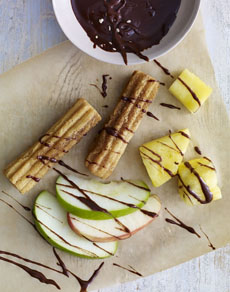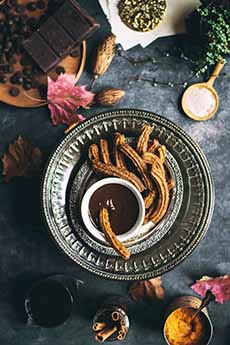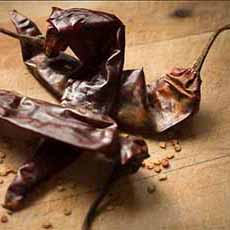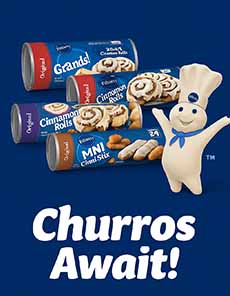Spicy Chocolate Fondue Recipe With Churros & The History Of Churrros
|
|
For Día de los Muertos, celebrated today and tomorrow, serve something with a south-of-the-border theme. We’ve got an exciting chile mole fondue; use churros (South American crullers) for dipping. There’s more about Día de los Muertos below. This recipe, uses three types of chilies—guajillo, chilies de arbol and chipotle—to give this Mexican-inspired dessert fondue a smoky kick. Bittersweet and semisweet chocolate, nutty peanut butter and warm cinnamon make it a luscious complement to churros, fresh fruit or assorted cookies. You can also try pumpkin tortilla chips, which have matching spices and a touch of sweetness. Here’s a recipe to make classic deep-fried churros. You can also buy them in Latin American grocery stores. But we prefer the recipe for baked churros shown in photos #2 and #3. > National Churro Day is June 6th. > The history of churros is below. > So is the history of El Día de los Muertos. > Plus, check out the substitutes you can use instead of deep-frying churros. In addition to churros, you can use this spicy chocolate fondue with anything you like. Check out this selection of chocolate fondue dippers. Note that the serving size in this recipe (which is from McCormick) is 2 tablespoons—enough for a mouse! If you want a larger portion, double the recipe. Note also that this recipe is only for the fondue. You need to make or buy the churros separately. Tips 1. HEAT a medium saucepan on medium-high heat for 2 minutes. Add the chiles; toast 30 seconds per side or until they begin to blister and change color slightly. 2. LET the saucepan cool slightly. Add 2 cups water to cover the chiles and bring to boil. Reduce the heat to low; simmer 30 minutes until the chiles soften. 3. REMOVE the chiles with kitchen tongs to a blender container. Add 1/2 cup chile soaking liquid from the saucepan; cover. Blend on high speed until smooth. Discard the remaining soaking liquid in the saucepan. 4. STRAIN the chile purée through a large mesh strainer into the saucepan. Stir in the cream and corn syrup. Bring just to boil on medium heat, stirring occasionally. Remove from heat. 5. ADD the remaining ingredients; stir until the chocolate is melted and mixture is smooth. Garnish with toasted sesame seeds. Since pre-Colombian times, Mexicans have celebrated El Día de los Muertos, a ritual in which the living remember their departed relatives. From October 31 through November 2, graves are tended and decorated with ofrendas, offerings, and families expect a visit from loved ones who have passed. Ofrendas dedicated to the deceased, usually foods and beverages, are also put in homes on elaborately decorated altars with glowing votive candles, photos, chocolate and sugar skull heads (calaveritas). The churro is often thought to have originated in Spain, but it may, in fact, have come from China. It is similar to a savory Chinese pastry (no sugar), dough sticks called youtiao, which are fried in oil. The result is a crispy outside and tender crumb. Here’s a recipe. Portuguese explorers, who traded with China as early as 1514, may have brought youtiao back to Portugal. From there, it hopped the border to Spain, where it evolved into the sweet, cinnamon-accented pastry we know today. Churros were introduced to Mexico and South America during the Spanish exploration and conquest in the mid-1500s. This was about the same time that the Spanish returned to Europe from Mexico with cacao…and ultimately, Spanish cooks turned that turned into hot chocolate and chocolate sauce. In Spain, the pastry got its from being piped through a churrera, a syringe-like utensil that features that unique shape. Churros can either be straight or spiral-shaped. The churrera (an inexpensive tool) comes with different attachments, so choose whatever you like! (You can use the churrera to make cookies as well. Its design is similar to a spritz cookie press.) After frying or baking, our modern churros are rolled in cinnamon sugar. While churros are served as a dessert in Mexican-American restaurants, café con leche and churros are popular breakfast items in Latin America. While traveling from country to country, the churro was enhanced, from guava-filled churros in Cuba, the dulce de leche-filled churros in Mexico, and cheese-filled churros in Uruguay. Dulce de leche, a popular sauce for churros, was invented in Argentina in the 19th century. The first historical reference to the Argentinian dessert comes from a peace meeting between military leaders in 1829. According to legend, dulce de leche was produced by accident when the maid was cooking some milk and sugar and was unexpectedly called away. Upon her return, the mixture had transformed into a thick, brown consistency (not very different from caramel sauce, which is made with sugar, cream, and butter). The “new dessert” was called dulce de leche, a milk sweet [confection]. Today it is usually made with sweetened condensed milk (which did not exist at the time). Contemporary creative churro bakers have made churros in different flavors, made them hollow to be stuffed with different fillings, made them into jumbo-sized loops, made them mini-bite size, and continue to work their magic on an already-magical magical pastry. Check out these rainbow-colored churros for Pride Week. Making churros from scratch, with star-tipped piped pastry fried in hot oil, may be too much for most of us. Here are easier alternatives to dip in that delicious sauce, that deliver the same warm, cinnamon-sugar flavors. |
|
|
CHECK OUT WHAT’S HAPPENING ON OUR HOME PAGE, THENIBBLE.COM. |
||











